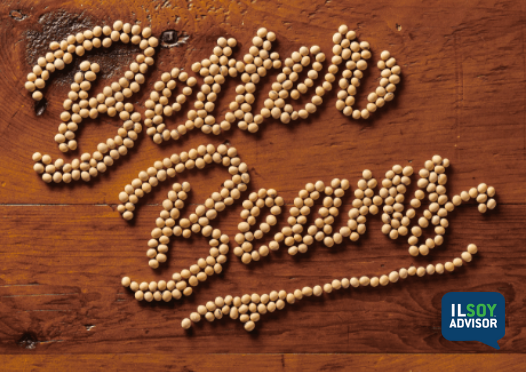ILSOYADVISOR POST
Agronomy: Field Days Preview: Soybean Fertilization
Historically, many producers didn’t (some still don’t) fertilize their full-season and double-crop soybeans and left them to scavenge for nutrients the following year. High-yield soybeans require adequate fertilization, the same as a corn or wheat crop, and should be included in your fertilizer management plan. A soybean crop of 60 bu/ac can remove a fair amount of phosphate and potash. See the table below.

As a consultant, I deal with a wide variety of customers who have varying philosophies with regard to soybean fertilization. Most of my producers have strict fertilization programs for the phosphorus (P) and potassium (K) needs of their corn, soybean and wheat crops. I have producers who fertilize their respective crops annually, while others fertilize biennially (every other year). This saves a little money by reducing the number of trips across the field.
Many of these “biennial guys” have their own variable rate spreader. With this technology growers can apply DAP (diammonium phosphate) fertilizer ahead of the corn crop to take advantage of the nitrogen and apply the potash (potassium chloride) fertilizer ahead of the soybean crop.
However, I have a few producers who don’t apply P or K fertilizer to subsequent full-season or double-crop soybeans. In those instances, I personally feel they aren’t reaching the maximum yield potential of the soybean crop, unless the soil tests are high enough to support it.
What are the consequences of not applying fertilizer to soybeans? Well, it first depends on your soil test levels for P and K. With regard to omitting P on soils that test high to intermediate, yields will generally not be adversely affected. However, soil test levels for P will decrease over time. Soils that test low for P will also see a decrease in soil test values and research in Iowa showed a decrease in yield of up to 70% compared to supplying adequate fertilizer.
Potassium is a little different in that soil test levels can drop dramatically when K fertilizer is omitted. Generally, there is little chance of yield decreases if K is omitted on soils with an initial soil test greater than 360 lbs./ac. This value is significant, since most soil tests for K on row crop operations are below 250 lbs./ac, especially in southern Illinois on the soils I have tested.
In 2015, an article was published by Ross Bender, Jason Haegele and Dr. Fred Below titled “Nutrient Uptake, Partitioning, and Remobilization in Modern Soybean Varieties”. The article outlined when and where nutrients are distributed within the soybean plant throughout the growing season. The article can be downloaded for free from the University of Illinois-Crop Sciences website here.
The graphs below taken from this article show the uptake and partitioning of nutrients in the soybean plant and stress the need for adequate soybean fertilization.
 \
\
My main takeaway from their article is: approximately 80% of the accumulated P and 46% of the accumulated K in a soybean crop are removed with the grain, which is about 75 lbs./ac phosphate and 130 lbs./ac potash, respectively.
Remember, plant roots contact only a small percentage of all available nutrients. Therefore, P and K fertilization is necessary to ensure that adequate levels are in the soil for plant uptake.
Come to the ILSoyAdvisor field days on August 4th in Benton to learn more about how fertility impacts soybean yield more than you may realize.
Terry Wyciskalla is an independent crop and soils consultant based out of Nashville, Illinois. He specializes in soil sampling, fertility recommendations, precision ag services and crop problem diagnoses. He serves a 12-county area throughout Illinois. He earned his 4R Nutrient Stewardship certification in 2015 and is happy to be a part of the 2016 Soy Envoy team.




Comments
Add new comment